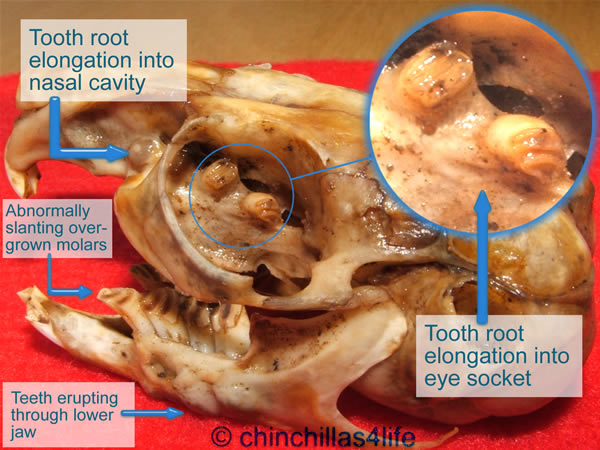Please email me, or find me on the chinsrus forum
If you want to take a look at some of the products and toys that help us with the costs of running the sanctuary, then please visit our shop
Many thanks to everyone for all their support
Chinchillas are exotic animals that have specialist needs.
Generally, they are fairly healthy in captivity, however serious problems
may arise and can rapidly become life-threatening if not dealt with quickly.
We advise you to find a good vet who has an interest in
chinchillas and to always err on the side of caution.
There are many excellent sites that provide invaluable information about chinny health, so have a browse about or take a look at our
Info. Sources page for a quick start.
We have put together some of our findings and knowledge below.
Malocclusion | Castration | Diabetes | Heat | Lipidosis
Incontinence | Pancreatitis | Quick Guide | Ringworm
Malocclusion
Unfortunately, many chinchillas suffer from dental problems known as malocclusion. The upper and lower teeth can elongate and the roots grow into the eye and brain. This is very painful for the chinchilla and usually leads to the chinny being put to sleep.

Dental surgery may help in the short term, but often the end result is the same.
Malocclusion is a painful and often fatal dental disease in chinchillas that MAY be helped with a better diet. There has been some research regarding malocclusion, and the evidence seems to indicate that the diet of captive chinchillas may have a role to play.
As with all rodents, chinchillas teeth grow constantly throught their life. The idea is to increase the wear on the grinding surfaces of the teeth to a level
more similar to that found in the wild. We do this by encouraging them to
eat dried vegetables, berries and herbs which have long unbroken fibres in them that act like an abrasive on the teeth.
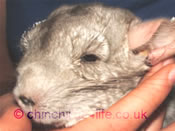
Malocclusion should be suspected if your chin has dampness or
flattened fur around the eyes and/or dampness around the chin (slobbers) and/or weight loss
or small,dry poos.
You may also find that your chin is
having difficulty eating, paws at its mouth or grinds its
pellets into powder.
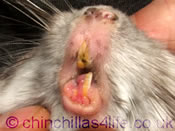
You should also check your chins front teeth (incisors). They should be short enough for the chin to be able to close its mouth properly and not curled, split or missing. They should be a good orange colour.
In some cases, a lower tooth root may erupt from the lower jaw resulting in an abscess. This is unlikely to be treatable, and will probably result in osteomyelitis as well. The chances of survival are slim.

Malocclusion must be confirmed by a vet with xrays. You should NEVER hesitate to get your chin checked, as your chin may be in pain, and the teeth can continue to grow especially if your chin is having difficulty eating.
Top of pageCastrations
Castrations of chinchillas are becoming very common. Most vets are aware about the risks of using anaesthetic in chinchillas as in many other small animals.
The youngest chinny that we have had castrated was four months, at about the time when he could have become sexually active. We have heard of a chinchilla
becoming pregnant to a 17 week old male! and so if your vet suggests a castration at a later age, then you will have to separate him from females until that
time.
Isoflurane gas should be used for this operation as it has no physiological effects on the body. Recovery is very quick.
We get our males castrated when they come into us and have had many done now. We have had a couple of minor hiccups but no great problems.
If you wish to have a chin castrated then its always advisable to check out the vets first to see if they have any knowledge of castrating chinchillas.
Dont be afraid of asking questions and finding out if they have castrated chins in the past with success.
My vet charges us £30 ish for a castration. Prices do vary.
Your vet should advise you on aftercare. Antibiotics are often supplied along with probiotics (always ask for painkiller - normally Metacam).
I always take some food and hay with them for after the op as this helps the vet to see when they are alert.
When you collect your chinny, keep him in his carrier for a little while where you can keep an eye on him. Keep him quiet and warm (NOT HOT)!
Keep a close eye on the operation site for any signs of infection.
Your chin may walk around very slowly and hunched for a good few days ... he will often stretch in pain. You will need painkiller for at least three to four days post op.
Hopefully your little fury friend will be feeling well again soon.
JUST A NOTE.
It is always much safer to have a male castrated than a female spayed. Females should not be considered for spaying unless there is a medical
condition that necessitates such a major operation.
Unfortunately, complications occasionally occur.
because of infection
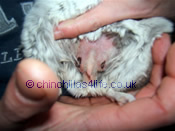
After castration I would advise people to check their chins wounds for up
to four weeks after the operation.
Even after a post-op. check with everything looking fine after 12 days, Mickey
developed problems.
His wounds had become swollen and infected. The cause of this is under
debate as another chin that was castrated at the same time had the same problem, but his
was easier to deal with.
with sterile water
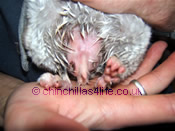
Mickey was put back under and his wounds were drained and cleaned. They
applied some kind of internal antibiotic. Unfortunately a day later and
they were swollen yet again. I went back to the vet and the poor guy had
to have the unpleasant procedure done again.
I had to keep cleaning out the wounds hoping to get on top of the
infection with the help of Baytril.
Mickey is doing fine now and is totally recovered. He even has a female partner to keep him company, so maybe it was worth
it for him !

A prolapsed penis is another complication of castration. This little chap came to us seven months after being castrated. The previous owners vet could not do anything to correct this and after a few discussions with our vet it was decided there was nothing we could do other than continue to lubricate it.
Top of pageDiabetes
Diabetes is rare in chinchillas. It has similar clinical signs to other animals and humans eg. polyuria (increased urination), polydipsia (increased drinking), weight loss, cateracts and ketones ('pear drops' smell on the breath). It can be diagnosed with a simple blood test which would show a high blood glucose level (the normal level is 3.3 - 6.1mmol).
The diet should be altered to give high protein, high fibre (chins should have plenty of fibre at all times) and low fat. They should have NO treats or sugary fruit. They can also have regular insulin injections, but practically this may not be possible.
We are very pleased to say that we have had a great success with a
diabetic chinny that was very poorly and fitting every day. We sent out some of our veggy and herb mix to Louise to
see if it would help Chewie and the results were great. Please have a read of Chewies Story to see how diet can
help these chins.
Heat
High temperatures can be deadly to chinchillas. They must be kept cool. Temperatures above 21°C, 70°F can be fatal. Ideally they need to be kept at 13-18°C, 55-65°F with a humidity of 40- 60%. If you have air-conditioning then get it on and keep a close eye on them when the weather is warm.
Chins are very susceptible to heat stroke. Unlike many other animals, chins do not sweat and so placing a fan in their room is no use to them.
Their environment needs to be cool AND dry. It is vital
that the combined temp and humidity levels DO NOT reach or exceed 150. At this point death could be imminent.
A gauge showing both temp and humidity levels can be purchased cheaply from many garden centres. An air con unit should be considered a necessity as this could mean the difference between life and death.
Alternative methods include:
- Placing a biscuit tin filled with ice packs on top of their cage ( this will cool the hot air as it rises )
- Place frozen water bottles wrapped in a towel into their cage
- Putting a granite 'chin chiller' in the cage to allow your chins to lay on it , these can also be placed in the freezer to cool further for a while
( ensure any ice is removed first though ) - Terracotta saucers or tiles can be placed in the freezer and then put in the cage
- Placing an ice cube in the chins cage allows them to cool their body temperature
- Sand baths can be placed in the fridge for a few minutes before giving to the chin
- Place the chin in the freezer for a few minutes at a time, leaving the freezer door slightly ajar so that you can watch him closely
-OR- - Immerse the chin up to his neck in cool or lukewarm, NOT COLD, water. Cold water could cause him to go into shock. When he livens up, dry him lightly with a towel in a cool room. After he has dried off allow him to have a sand bath to assist with the drying of his coat
Many thanks to Linda for this advice.
Top of pageHepatic Lipidosis
Many people will feed peanuts, sunflower seeds and other fatty treats to their chinchillas. When we take in rescues, they often come with a bag of peanuts along with other little sins!
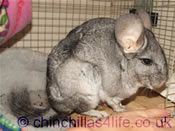
The problem with feeding chinchillas peanuts/fatty treats is all down to their inability to metabolise fats. I will not feed my chins peanuts and I have seen the problems caused by this. Chinchillas need some essential fats but it is always better to never over do it. Hepatic lipidosis is a condition of the liver caused by an overload of fats. The liver eventually becomes swamped with fat globules which stops any nutrients from reaching the liver cells. This leaves a very sick chinchilla . The chin shown came to us as she was very ill and her owner didn't know why she was losing weight. Her owner was killing her with kindness by giving her and her sister four whole monkey nuts a day. We fed her and medicated her for around six weeks. She ate very well, but as her liver was swamped with fat, she sadly never gained weight and died. Giving one peanut rarely may do no harm, but with so many other healthy goodies that they really love, I don't really see the point.
Chin-Chin

Chin-Chin is another poor chinny who was fed an horrendous diet of nuts,
nuts and more nuts. When he came in to us his back end was matted (often
assosiated with dental issues) but he had no ther symptoms. After changing
his diet over, he started to slobber and his fur around one eye was damp.
After a check at the vets and xrays, it was found he had a spur and slightly uneaven teeth
(no suprise).
His roots were fine.
He was back to normal and ate well but the problems
started agian.
Chin-Chin would paw at his mouth and have the slobbers on
and off. Most chinchillas who have the slobbers have a constant wet chin
and on investigation by your vet they often find a reason for it such as a
sharp piece of tooth/spur/abcess/foriegn body (such as a piece of wood or
hay)/Periodontal food impaction (rotting food trapped between gaps in the
teeth which should not be there).
Sadly in Chin-Chins case after further checks and more xrays, no
explaination could be found as to why he was wet on and off. As with
Skinny Minnie, our thoughts at first with her was her teeth until we had
xrays and found her teeth to be ok. Then her blood test came back and we
knew it was lipidosis. She too started to slobber with no explaination but
added to the blood test we knew it was down to hepatic portal shunt (her
trying to get rid by blowing off the toxins from her body which had built
up). Sadly skinnys sister also died not long after her.
Chin-chins symptoms were very much the same and sadly he died.
Charlie

Charlie is another chinchilla who we lost this weekend 01/12/07 after
virtually the same symptoms as above and after checks at the vets we knew
he had some dental issues.
The issues he had did not match up with his
symptoms and yet again he had slobbers on and off with xrays and checks to see if
we were missing something.
Charlie was happy, bouncy and eating well.
His slobbers were on and off but his weight was OK with no drastic loss of
weight, although he was obese when he came to us .
He lost fur for no
apparent reason (not bald patches, just fur loss) and some matting as with
Chin-Chin.
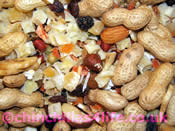
We have kept a really close eye on Charlie and watched him over time, but sadly
he was found collapsed and there was nothing more we could do apart from
hold him until the end which was quick and peaceful.
I had to put my mind at rest and had a post-mortem performed. From the results we can
only assume he also died from lipidosis.
PLEASE do not feed your Chinchillas high fat treats.
If you have a chinchilla who has the slobbers on and off and no other
explaination can be found for this, consider lipidosis.
I am sure this goes
undiagnosed quite often and is mistaken for dental issues.
Lipidosis can be treated with steroids/lactulose/vitamin B injections but I
guess it has to be diagnosed early on to have a happy outcome.
Incontinence
Incontinence in chinchillas is very rare - we have only had one case in the rescue here. The cause is thought to be due to a genetic deformity of the bladder, although an untreated UTI (Urinary Tract Infection) can lead to incontinence. There are other possible causes too.

Holly was left in a pub by someone who said he would shoot her if someone wouldn't take her! Luckily a lady took her home and
tried to care for her until she found us. She asked us to take her in and said she that she had been dirty underneath from day
one.
The smell from Holly was horrific and her bottom was so very sore and scalded. If you look closely at her tail in the picture opposite, you can see that it is stained dark drown by the urine! When she walked she had her bottom very high
in the air as she was so sore and miserable.
We treated Holly for an infection to see if this was the problem, but it didn't help.
Holly had to be washed with Hibiscrub, and have her fur clipped around her genitals to help keep her dry.
We used a barrier cream on her to prevent her getting sore and to stop any more urine scalds.
After many weeks Holly certainly
became much happier and smelt better! She needed daily washes to keep her clean.
After long chats with the vet, they thought it may be useful to try an unlicensed drug called Propalin which is used to tighten
the bladders of cats with urinary troubles. We used this treatment for a while and it did seem to help a little. We got washing
Holly down to around every two or three days as she just wasn't as wet.
Holly went to a new home where she sadly died after a couple of months.
This condition is not nice for the chinchilla and you often question if you are doing the right thing.
All I know is that Holly
was happier when she left us than when she came to us.You can also read about another case on Debbies site, Azure Chinchillas.
Pancreatitis
THIS IS A STORY ABOUT A CHINCHILLA CALLED HUEY WHO SUFFERED FROM PANCREATITIS.
After 4 months of treatment, my 9-year-old chin was finally diagnosed with pancreatitis (inflammation of the pancreas) after being referred to a specialist vet. Unfortunately the two months help we then received came too late to save her. I am hoping that by writing this I can prevent others from going through the same thing. I stress that I am not a vet, but wanted to share the information I have acquired over this past six months.
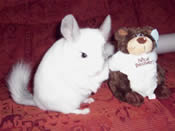
Pancreatitis in animals tends to be caused by a diet high in fats, toxins, drugs, genetics or worms. There are also other factors that can trigger pancreatitis. It tends to occur in dogs and cats, so unfortunately little research exists for chinchilla pancreatitis, so treatment is hit and miss and still relatively unknown.
Diet
The golden rule is to avoid foods that are high in fat. I have been told that on the whole a chinchillas basic diet is relatively low in fat and should not trigger the disease. However, treats are a different story. Chinchillas love sunflower seeds and nuts. These are high in fat and if overfed can cause various health complications. I would urge owners to leave them out entirely, eliminating a potential risk factor.
Toxins and drugs
Vigilance with regard to what they eat is essential. In our case we believe the trigger was toxins caused from eating some paint from some artificial coal, something my fuzzy had eaten in the past but had not been affected by. She had taken a shine to it and despite covering it up, being watched, and repeatedly being removed from the area she had managed to eat it in a larger quantity. The situation was not helped by the vets advice when she lacked appetite to try and tempt her to eat with sunflower seeds.
If the little fuzzys eat something they shouldn't then please get vet treatment ASAP, and be very insistent if you feel they have eaten something toxic. Despite taking my chin to the vets after the event, her tummy probs were treated with antibiotics and seemed to work, but the cause was never addressed. As she had suffered no previous affect from eating the coal it seemed the problem had been cured. Perhaps if she had her tummy cleaned out we would not be where we are today? Despite having continued problems, the original suggestion of it being the coals was ignored and dismissed.
Genetics and worms
These are both things that can cause pancreatitis but unfortunately I know little about them. The pathologist who analysed my chins blood test results had never come across a case of chinchilla pancreatitis before and had difficulty finding any information on it. So it is either very rare or it may be that as the symptoms are so similar to other illnesses that perhaps it has never been diagnosed before?
The symptoms we encountered:
One minute she was absolutely fine, the next she would sit with her back hunched up, which could be attributed to back pain that sufferers can feel. She would then, as the symptoms got worse, progress to continually wanting to lie down all the time. She would be incredibly tired and lethargic. She couldn't settle in one place she would fidget constantly, at its worse changing sides and places. She used to use her cuddle cup as a toilet and plaything. When ill, she used to take comfort from actually sleeping inside. When bad she would show some interest in food hand fed. Bowl visits were few and far between and she didn't want to come out and play.
Her bad spells came round in cycles. At worst she would have a few days of good then a few days of bad.
In the run up to her bad times she would eat excessively and sometimes drink excessively as if she was stocking up. She would come out and be excessively energetic too.
The problem with pancreatitis is that it is so difficult to diagnose as the symptoms are so varied, they could be misread to be other illnesses.
Our chins symptoms were put initially down to diet but having kept a diary there was no specific trigger to her bad times. We restricted her diet back to the bare essentials - bowl mix, hay, water and low fat treats. But again no one trigger set off her bouts of lying down. External factors were also blamed too, carpet, wallpaper etc. triggers that she hadn't eaten around the time of bad episodes and were ruled out.
Her urine would be normal one minute but dark orangey-red the next, symptoms that suggested kidney problems again which was systematically treated. Later blood test results showed normal kidney function. As time progressed much later, results showed kidney problems.
Her poops were never 100% from day one of our experience. One minute normal, the next very small. Sometimes long and thin sometimes quite chunky. Symptoms that suggested a blockage but was ruled out after surgery.
Blood tests taken by the specialist vet eventually helped diagnose pancreatitis. With larger animals a biopsy is removed from the pancreas but as chins are so small, their pancreas is too small and too rich in blood vessels to use this as a diagnosis tool.
Treatment for the disease normally involves removing the cause then going on to treat, to remove and to make comfortable. There isn't one specific medicine to cure it, unfortunately, but there are ways to treat, manage and sometimes eradicate the disease. Sometimes the disease can be reoccurring. Each case is different.
We were given various antibiotics and painkillers during the course of her illnesses that helped in varying degrees at different stages.
With dogs and cats treatment tends to centre on having the animal admitted and starving them whilst keeping their liquids up. Food triggers the pancreas to work so by removing food it helps the pancreas to heal. This was not an option with chins as it is a necessity to keep their stomachs turning over.
Our vet was really good and supportive. He continued to seek options that could perhaps help us, as when she was well, she was really well and to look at her you wouldn't believe she was ill. The last treatment option he suggested had shown positive results in rats and had gone on to actually be used as a treatment in humans. Unfortunately despite showing early promise, once off the treatment she went down hill quite quickly. Her disease was too far advanced. It was heart-breaking. Eventually it was obvious that she had had enough. She gave up eating and refused even her most favourite food items. So we had to make the decision to have her put to sleep. It was the best thing for her.
I hope this information has proved helpful in someway in improving awareness of this disease. Early diagnosis would make all the difference. Chins are so loving and precious. Make the most of every second you have together.
Melanie, Hueys mum
Quick Guide
In November 2007 we ran a competition to see who could write the best short article on basic care for your Chinchilla. Many congratulations to Sharon Montgomery for winning the competition and to Deborah Solloway for being runner up. The following guide is taken mainly from our winner with a few additions from our runner up. Many thanks to everyone who submitted an entry.
What you need to know beforehand
Research the Chinchilla as a pet using reference books, internet sites or by speaking to experienced Keepers/Breeders through forums. Learn how best to house them, care for them, feed them and what to do in an emergency. The initial costs can be high with cages, food and toys, and always bear in mind veterinary treatment is expensive should your pet become ill or injured.
Think about how your new pets requirements and how these will fit in with your life:
- do you really have the space?
- can you commit the time and the money?
- how will your existing pets react or vice versa?
Chinchillas are highly intelligent creatures (they learn and remember) and will require at least an hour of your time everyday (not including cleaning). It is not good for the Chinchilla's health to be left alone in the corner of a room without any contact. A single Chinchilla will require even more of your time because it will regard YOU as its mate. A bored Chinchilla may become depressed or ill and may chew its own fur.
Remember Chinchillas are not suitable for children as they are nocturnal creatures who can be very noisy at night or easily scared by loud noises or suffer stress and injury or fur loss (or worse, tail loss!) by being held incorrectly.
A nervous Chinchilla may also bite and must be held correctly. Hold and support the Chinchilla with both your hands, holding it securely against your body.
Where will I buy my pet?
If you decide a Chinchilla is the pet for you then your next thoughts will probably be:
- where shall I get my Chinchilla from?
- what sex of Chinchilla is best for a pet?
- should I buy one or two Chinchilla(s) and of which sex?
Chinchillas are best kept in same sex pairs. If a male and female are to be kept together, then the male should be neutered to avoid any unnecessary pregnancies and unwanted kits. The neutering procedure for males is a simpler and easier procedure than that of females, for this reason mostly the males are neutered.
If you buy two brothers or two sisters they will usually live together happily. It is not advisable to put two Chinchillas that do not know each other together until proper introductions have taken place over a few weeks or months as they will fight and injure each other and can even kill.
If you buy from a breeder you can usually get a three generation pedigree so you will know your new pets family history.
If you adopt from a reputable rescue, the Chinchilla will have been quarantined and will have had a veterinary health check, and will have been with the rescue long enough for them to determine its general health and attitude before it is re-homed. Both of these sources will also provide initial information and a continued supply of the food the Chinchilla has been used to.
Pet shops are generally not recommended as they give you no history or information about the Chinchilla you are buying, they don't always know how to sex Chinchillas properly and some people have ended up buying the wrong sex or even a pregnant Chinchilla!
Before taking your Chinchilla home, discuss the Chinchillas current diet and ensure you are given some of the pellets/food the Chinchilla is used to. Chinchillas have a highly sensitive digestive tract and any food changes must be made in slowly in small amounts, increased over a period of weeks to ensure that no digestive upsets occur. Mix the current pellets with those that you intend to use increasing the ratio of new pellets to old pellets over about four weeks.
When you get your new Chinchilla home leave him/her in the cage undisturbed for a few days to settle in. Talk quietly to the Chinchilla until it gets used to you and its new surroundings. Eventually she/he will come and sit on you hand.
Housing
Chinchillas are best kept indoors unless you have a fully insulated purpose built block or wood built shed. Chinchillas cannot withstand heat, draughts or damp and wet. Cages are then used within the shed. Hutches are not suitable for Chinchillas and a suitable Chinchilla cage should always be used. See the John Hopewell website for cage information.
Cages
A typical Chinchilla cage will be made from three quarter inch galvanised squared mesh that is at least three feet by two feet or bigger. Wide cages are better than tall cages but a tall cage can usually be split with a mesh division.
It must contain plenty of natural pine shelving secured at various heights in the cage to provide ledges for the Chinchilla to jump onto. Remember not to have any shelves higher than 18 inches as a Chinchilla can badly injure itself if it falls. Most good Chinchilla cages are made with a wire bottom and have a removable tray to catch droppings and urine and make cleaning easy.
Brush cages out daily to remove droppings and disinfect shelves and trays weekly with a suitable animal safe disinfectant such as Trigiene, Virkon, Vanodine.
The cage also needs a food bowl (that the Chinny can't throw about or chew), water bottle, a nest box so that your chinchilla has somewhere quiet to go for privacy, things to chew and other toys to help stimulate him while he is in his cage.
Location of Cage
Situate the cage in a quiet area where the Chinchilla will not be disturbed during the day. Ensure the area is well ventilated but does not have a draft. Do not position the cage beside a window where a draft could be present or sun rays will shine on the cage making the area hot.
Keep the Chinchillas cage in a cool area away from kitchen and central heating (ie radiators). Chinchillas cannot sweat and due to their thick dense fur will overheat and die quickly from heatstroke.
Remember this in warm weather, as you will need to monitor that the temperature does not exceed 23 degrees celcius. During excessive hot weather air conditioner units are a must for cooling warm Chinchillas, fans only circulate warm air.
Position the cage away from dogs, cats and other animals in the household that may harass the Chinchilla.
Sharing a cage
Chinchillas are territorial and will claim their cage space as their own. Never allow a strange Chinchilla to enter another's cage or even put a new Chinchilla into the cage of an existing resident - there will be a fight! Same sex or neutered pairs are best and introductions must be carried out before placing to strange Chinchillas together.
Diet
Chinchillas are strict herbivores and must be fed a diet that mimics what they eat in the wild which is very bland. A typical diet must be high fibre, low levels of protein and virtually no fat or sugar. A good diet also ensures your Chinchilla remains healthy and no other supplements are required. Avoid Chinchilla complete mixes which encourage selective feeing resulting in the Chinchilla only eating the bits it likes, but not everything it needs!
Chinchillas need hay as a part of their daily diet. Hay is a good source of fibre and helps to grind down the back teeth evenly. Timothy hay is preferable to meadow hay as it is of a higher quality, taste and is dust-extracted. The hay should be provided in a hay rack so that it does not become soiled. Readigrass can also be given in place of hay, to add variety. At Chinchillas4Life, we feed both hay and readigrass. We nust stress that hay is ESSENTIAL and not a choice.
Feeding the wrong diet is harmful to your Chinchilla and will cause illness, irreversible organ damage and most likely death. Chinchillas cannot tolerate sugar and cannot metabolise fat. For this reason never feed an abundance of food that contains sugar and be very careful with dried fruit which contains sucrose (fruit sugars), only one or two raisins per week for treats or don't feed at all. Never feed nuts which contain fats or seeds such as sunflower which can be high in protein.
The Chinchilla is a rodent, and its teeth grow continually throughout its life. Feeding hay, willow sticks and plenty of fibrous material to the Chinchilla to ensures a good chewing action which will strengthen the jaws and will help to wear down the teeth and keep them in shape. With a good diet teeth problems are greatly reduced.
There are various Chinchilla pellets available specifically manufactured to meet a Chinchillas health requirements.
In addition to a good quality pellets, hay and water must be provided fresh every day.
Treats
Treat items that can be given are dried herbs, one small raisin, one shreddie or mini shredded wheat, a small piece of apple (or fruit without stones). Always feed sparingly.
As described in the earlier section, always introduce new foods slowly over a period of weeks to minimise dietary upsets and diarrhoea.
General Care and Toys
Your Chinchilla will appreciate some time outside of its cage to run and exercise fully. This is an excellent time to play and interact with your Chinchilla and time for bonding with you pet. Do ensure that the exercise room is Chin-proofed i.e. no cables, expensive furniture or dangers such as a toilet with the seat up! Supervise your Chinchilla at all times whilst they are playing. An accident can happen easily in the blink of an eye!
Wooden toys, willow sticks and willow balls etc. can be provided as gnawing toys for Chinchillas. This type of toy relieves boredom and promotes chewing to wear down growing teeth.
Fleece hammocks and tunnels are appreciated by Chinchillas as a comfortable and cosy place to sleep during the day. Hammocks can be used to provide an extra level in the cage and reduce falling distances.
There is a wide range of wooden toys available now for small animals - chinchillas love to destroy things! Wide cardboard tunnels are also fun, as are wood toys designed for parrots. It is best to avoid plastic toys and exercise balls, as they present health and safety risks for chins (Chins will overheat in an exercise ball, and they love to jump which they can't do in a ball).
Bath time
A sand bath can be given either in the cage or at playtime. In the wild Chinchillas bathe in volcanic dust to cleanse their fur of dirt and grease. The sand you use must be proper Chinchilla sand such as Sepioliate (no other types of sand). A bath given two or three times a week is sufficient. Remove bath after use as the Chinchilla may use it as a toilet! The sand can be sieved if not wet to remove droppings.
Veterinary Care / Emergency Care
Before you get your Chinchilla or as soon as you get your Chinchilla, identify a qualified veterinary surgeon in your local area, confident to treat Chinchillas. You never know when you might need to take your Chinchilla to a vet so its best to know beforehand where you will be going. Go to a few in your area and ask them what their experience with Chinchillas is. Many vets have very little knowledge when it comes to Chinchillas, but if they are willing to learn and research then they may able to help you with their problems.
Be observant with your Chinchilla and make some time to check its eyes, nose, mouth, teeth, feet and rear end. Knowing how your Chinchilla naturally looks will help you to identify any signs of illness. If anything is different or does not feel or look right, you might need to seek veterinary help. Always remember that Chinchilla's are prey animals, which means that in the wild your Chinchilla must always hide any signs of illness from predators or their own kind who may turn on them. This means that if you don't see any early signs of illness it may be too late once your Chinchilla starts to show signs of illness. It may be a good idea to weigh your Chinchilla fairly regularly. If their weight is not maintained, then see a vet straight away.
Breeding
Breeding is not recommended, and best left to the breeders who will understand the genetics of Chinchillas. Never breed from any Chinchilla you do not know the history of, and always remember that once your Chinchilla has kits they will be your responsibility to care for. Rescues up and down the country are full so don't expect to "off-load" your problems to them. They will try their best, but they are inundated with unwanted "pets" as it is.
Where can I get further support and advice for my Chinchilla
Always seek veterinary assistance if your Chinchilla appears different, seems lethargic or shows signs of illness such as pro-longed, un-explained diarrhoea.
Chinchilla forums are a great place to meet other Chinchilla owners and learn from their experiences and can sometimes help point you in the right direction. See our info pages for more sites to take a look at.
Many thanks to Sharon and Debs.
Top of pageRingworm
Ringworm is a fungus which effects the skin.
Chinchillas are very susceptible to ringworm, along with many animals and humans.
It is highly contagious and if not treated can infect you and your other animals.
Three fungi are significant in this disease...
- Microsporam canis
- Microsporam gypseum
- Trychophyton mentagrophytes
SIGNS OF RINGWORM.
Loss of fur from around the nose, eyes, genitals and possibly broken whiskers. The skin will be reddened. You may see tiny lesions, flaky scabs, scaliness and itching. Your chin may be scratching a lot as ringworm is very itchy.
Causes.
Ringworm CAN be caused by damp/humid conditions and un-cleanliness.
Sick or stressed animals are more susceptible to ringworm.
It is highly contagious and is passed on by atmospheric spores.
In the home dogs, cats and humans can also carry ringworm.
Possible prevention.
Keeping the temperature below 70°F by using an air-conditioning unit and de-humidifier.
Good quality damp and mould-free hay should be used.
Keeping your chinchilla quiet and stress free.
Regular exercise out of the cage.
And ALWAYS wash your hands.
Treatment.
Firstly quarantine any suspected cases of ringworm.
Then seek veterinary advice. Your vet should use a ultraviolet light which will help him to see if there is a possibility of ringworm. This test is not 100% accurate !
Your vet would have to take a fur sample to determine the cause. It takes up to three weeks for the cultures to grow, so in the meantime your vet may prescribe grisofulvin or another brand of medication.
Your vet may tell you to use anti fungal powder in your chins sand bath. If you do need to use this make sure all food is out of the way before placing the bath in.
You will need to clean the cage with a recommended cleaner such as Virkon S (or similar pet-safe disinfectant that is effective against fungal organisms). Make sure all the shelves and toys are also cleaned with Virkon too. Allow the cage to dry then return the chins to their cage.
Another thing which can help stop the spores from escaping is to use an opaque cloth to cover the entire cage during the daytime and to only open one side at night which will help to contain the spores.

